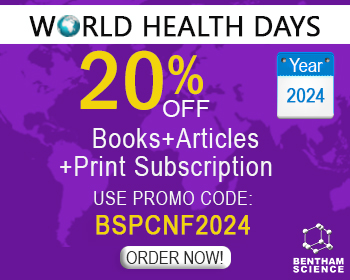Abstract
The plant kingdom is a rich source of compounds with anticancer activities. Curcumin [1,7-bis(4-hydroxy-3- methoxyphenyl)-1,6-heptadiene-3,5-dione] (1) is a secondary metabolite produced by rhizomes of Curcuma longa that has been used for centuries in traditional Medicine in Asia. Anticancer activity is one of the pharmacological properties of curcumin (1) that has been widely explored. Its targets include transcription factors, growth and angiogenesis regulators, apoptosis-related genes, adhesion-related molecules, and cellular signaling molecules. Some curcumin conjugates and metallocomplexes have been synthesized, characterized and evaluated for anticancer activity. In this mini-review, we discuss the mechanism of action by which curcumin (1) inhibits the progression of tumor growth and also the antiproliferative activity of curcumin conjugates and metallocomplexes on human cancer cells. The understanding of how these conjugates and metallocomplexes exert their anticancer activities is essential for future development of effective drugs.
Keywords: Curcumin, Curcumin conjugates and metallocomplexes, Cancer, Antiproliferative activity
Current Bioactive Compounds
Title: Curcumin Conjugates and Metallocomplexes as Lead Compounds for Development of Anticancer Agents - A Short Review
Volume: 4 Issue: 3
Author(s): Angelo de Fatima, Luzia V. Modolo, Ana Tereza M. Neres, Carmen V. Ferreira and Ana Carolina S. de Souza
Affiliation:
Keywords: Curcumin, Curcumin conjugates and metallocomplexes, Cancer, Antiproliferative activity
Abstract: The plant kingdom is a rich source of compounds with anticancer activities. Curcumin [1,7-bis(4-hydroxy-3- methoxyphenyl)-1,6-heptadiene-3,5-dione] (1) is a secondary metabolite produced by rhizomes of Curcuma longa that has been used for centuries in traditional Medicine in Asia. Anticancer activity is one of the pharmacological properties of curcumin (1) that has been widely explored. Its targets include transcription factors, growth and angiogenesis regulators, apoptosis-related genes, adhesion-related molecules, and cellular signaling molecules. Some curcumin conjugates and metallocomplexes have been synthesized, characterized and evaluated for anticancer activity. In this mini-review, we discuss the mechanism of action by which curcumin (1) inhibits the progression of tumor growth and also the antiproliferative activity of curcumin conjugates and metallocomplexes on human cancer cells. The understanding of how these conjugates and metallocomplexes exert their anticancer activities is essential for future development of effective drugs.
Export Options
About this article
Cite this article as:
de Fatima Angelo, Modolo V. Luzia, Neres M. Ana Tereza, Ferreira V. Carmen and de Souza S. Ana Carolina, Curcumin Conjugates and Metallocomplexes as Lead Compounds for Development of Anticancer Agents - A Short Review, Current Bioactive Compounds 2008; 4 (3) . https://dx.doi.org/10.2174/157340708786305934
| DOI https://dx.doi.org/10.2174/157340708786305934 |
Print ISSN 1573-4072 |
| Publisher Name Bentham Science Publisher |
Online ISSN 1875-6646 |
 10
10
- Author Guidelines
- Graphical Abstracts
- Fabricating and Stating False Information
- Research Misconduct
- Post Publication Discussions and Corrections
- Publishing Ethics and Rectitude
- Increase Visibility of Your Article
- Archiving Policies
- Peer Review Workflow
- Order Your Article Before Print
- Promote Your Article
- Manuscript Transfer Facility
- Editorial Policies
- Allegations from Whistleblowers
- Announcements
Related Articles
-
<i>Arctium Lappa</i> and Management of Liver Functions to Detoxify the Bloodstream
The Natural Products Journal Tumor Stroma Manipulation By MSC
Current Drug Targets Proteomic Classification of Breast Cancer
Current Drug Targets Heterocyclic Compounds as Anti-Inflammatory Agents
Current Bioactive Compounds Targeted Tumor Therapies at a Glance
Current Drug Targets Targeting Vesicle Trafficking: An Important Approach to Cancer Chemotherapy
Recent Patents on Anti-Cancer Drug Discovery NBN Polymorphysms and Cancer Susceptibility: A Systematic Review
Current Genomics Chemoprotective and Carcinogenic Effects of tert-Butylhydroquinone and Its Metabolites
Current Drug Metabolism Partners in Crime: NGF and BDNF in Visceral Dysfunction
Current Neuropharmacology DTCM-glutarimide Delays Growth and Radiosensitizes Glioblastoma
Anti-Cancer Agents in Medicinal Chemistry Recently Patented Applications of Homologous Cellular and Extracellular Agents as Therapeutics or Targets for the Prevention of Restenosis Post- Angioplasty
Recent Patents on Cardiovascular Drug Discovery Synthetic Methods for the Preparation of Triazepandiones and Review of their Applications
Current Organic Chemistry Cancer Chemoprevention with Green Tea Catechins: From Bench to Bed
Current Drug Targets The Therapeutic Potential of Gallium-Based Complexes in Anti-Tumor Drug Design
Letters in Drug Design & Discovery Metal Containing Cytostatics and Their Interaction with Cellular Thiol Compounds Causing Chemoresistance
Anti-Cancer Agents in Medicinal Chemistry Patent Selections
Recent Patents on Endocrine, Metabolic & Immune Drug Discovery TGR5 as a Therapeutic Target for Treating Obesity
Current Topics in Medicinal Chemistry Glutathione Transferases: Emerging Multidisciplinary Tools in Red and Green Biotechnology
Recent Patents on Biotechnology Advanced Platelet-Rich Fibrin Extract Treatment Promotes the Proliferation and Differentiation of Human Adipose-Derived Mesenchymal Stem Cells through Activation of Tryptophan Metabolism
Current Stem Cell Research & Therapy Infection and Malignancy Risk in Patients Treated with TNF Inhibitors for Immune-Mediated Inflammatory Diseases
Current Drug Safety























